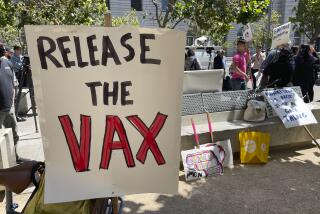Swine flu vaccine production running behind by about 25%, officials say
- Share via
LOS ANGELES AND MEXICO CITY — As the so-called swine flu sweeps through the Northern Hemisphere once again, U.S. officials on Friday downplayed the impact of vaccine shortages, and Mexican officials stressed good hygiene and prompt medical treatment for flu-type symptoms.
Officials at the federal Centers for Disease Control and Prevention had expected about 40 million doses of the swine flu vaccine to be distributed by the end of the month, but it looks as though a maximum of 28 million to 30 million doses will actually be shipped, said Dr. Anne Schuchat, director of the CDC’s National Center for Immunization and Respiratory Diseases. That’s about 25% fewer than expected.
“Vaccine production is pretty complex, and it is taking a bit longer than we would hope,” she said at a news conference Friday.
In particular, growing the virus in eggs has not yielded as much antigen -- the crucial component of the vaccine -- as is normally obtained with the seasonal flu.
Despite the current low production, however, there are no plans to use adjuvants -- chemicals added to increase the immune response to the antigen -- to extend the supply of the pandemic H1N1 vaccine, said Dr. Jesse Goodman of the U.S. Food and Drug Administration. Many people who are reluctant to get vaccinated believe, mistakenly, that the adjuvants are toxic.
As of Wednesday, 11.4 million doses of vaccine were available, slightly more than half of that in the injectable form; states had ordered 8 million doses; and nearly 6 million doses had been shipped -- including 836,900 doses to California.
Mexico was facing similar shortages of the H1N1 vaccine. Officials had promised 30 million doses, but now say they don’t expect the first batch of 5 million to 8 million doses until late December. The delay was attributed to the huge demand for vaccines around the world.
Despite those delays, reaction to the H1N1 pandemic in Mexico has been more muted than it was in the spring, when the country was the first to be hit hard by the outbreak.
Nearly 20,000 new cases of swine flu infection have been confirmed in that country since early September, with at least 61 fatalities, according to health authorities there. That contrasts with the nearly 42,000 cases and 260 deaths reported since the outbreak began in the spring -- though authorities cautioned that the winter flu season has just begun.
In April and May, authorities in Mexico City tried to prevent further infection by closing schools, cinemas and museums and allowing restaurants to serve only take-out food. Those shutdowns, along with a drastic drop in tourism because of the flu outbreak, damaged Mexico’s already limping economy.
This time, health officials are stressing good hygiene and prompt medical treatment for flu-type symptoms, but say there is no need for widespread precautionary closures.
Health Secretary Jose Angel Cordova said Thursday that the H1N1 virus, though new, has proved no worse than ordinary seasonal flu. Pandemic H1N1 influenza “is a benign illness, caused by a viral cousin of the seasonal [flu], with the same rate of transmission and mortality, so there is no reason for alarm,” Cordova told a gathering in the western state of Jalisco.
Mexican newspapers carry regular updates on the latest outbreak, and many restaurants offer customers a squirt of antibacterial gel, but there is no sign of panic in the streets. Few residents are seen wearing the surgical face masks that were ubiquitous in the spring.
Meanwhile, in the United States, spot shortages of seasonal flu vaccine have also been occurring because manufacturers have had to juggle production of the two types to ensure the availability of swine flu vaccine. Some retail pharmacies and groups have had to postpone vaccination clinics because of the shortages, and some doctors say they have been unable to get enough vaccine to meet demand.
About 82 million doses of the vaccine have been shipped, amounting to about 71% of the 114 million doses expected for this season, Schuchat said. But most of the rest should be available by December, when the traditional flu season begins to peak.
Swine flu activity is widespread in 41 states, up from 37 last week, and all the other states are reporting regional or local activity, Schuchat said. That level of activity “is unprecedented for this time of year.” On average nationally, 6.1% of visits to doctors’ offices are for influenza-like illness, which is generally assumed to be swine flu.
“That’s very high at any time, but particularly in October,” Schuchat said.
In the week ending Oct. 10, there were 11 deaths of children from swine flu complications. That brings the total number of pediatric deaths since Aug. 30 to 43, and the total since the swine flu pandemic began in April to 86. About half of the deaths were among teenagers, Schuchat said. “Those are very sobering statistics.”
Schuchat warned parents with sick children to be alert for signs that medical attention is required. Those signs include not eating well, difficulties breathing, and turning blue or gray. A particularly important sign is when children start to get better, then have a relapse. That is usually a sign that pneumonia is developing, and immediate treatment should be sought.
Physicians should be on the lookout for viral pneumonia in all flu patients, officials from the World Health Organization warned Friday at the end of a three-day meeting in Washington of more than 100 experts from around the world.
The swine flu virus travels deeper into the lungs than the seasonal flu virus, and is thus more likely to produce pneumonia on its own, said Dr. Nikki Shindo of the WHO’s epidemic and pandemic alert and response department. In contrast, pneumonia produced by seasonal flu is more often a complication caused by a bacterial infection.
--
ken.ellingwood@latimes.com
More to Read
Sign up for Essential California
The most important California stories and recommendations in your inbox every morning.
You may occasionally receive promotional content from the Los Angeles Times.













